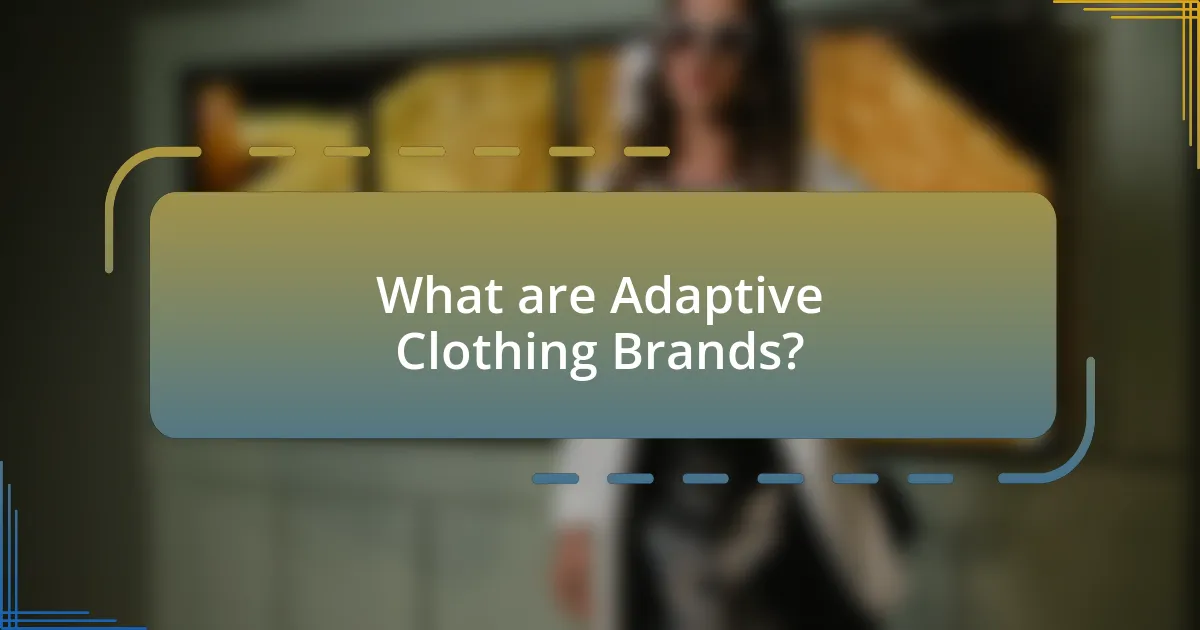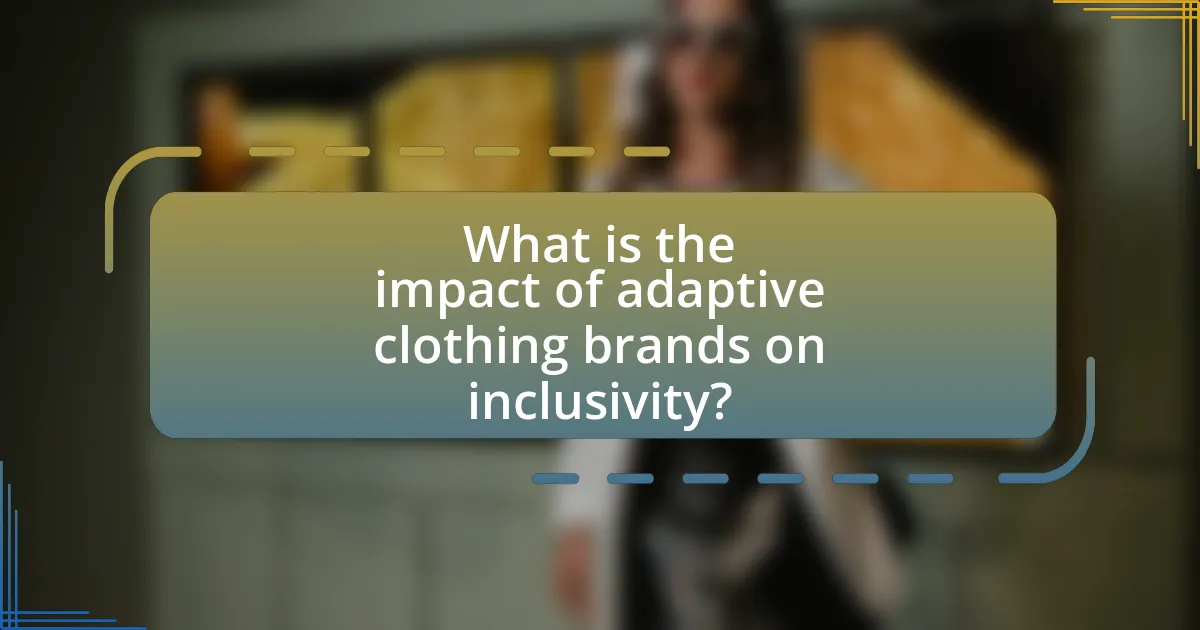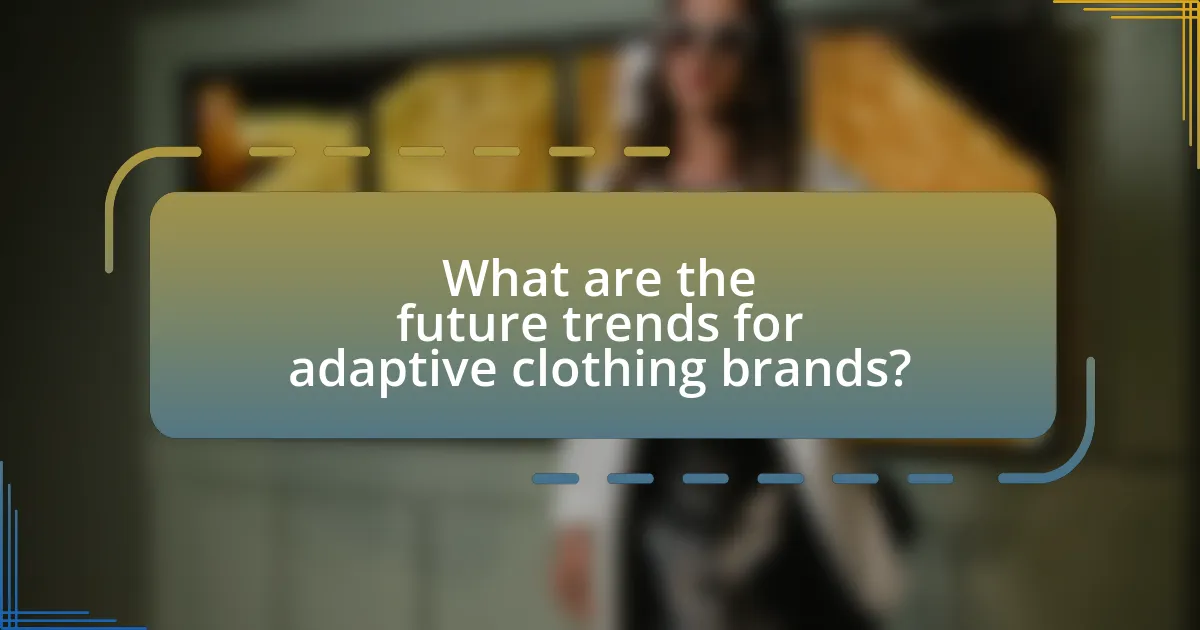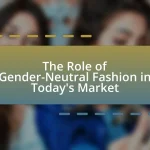Adaptive clothing brands are specialized companies that create garments designed for individuals with disabilities or specific needs, focusing on comfort and accessibility. These brands incorporate features such as magnetic closures, adjustable fits, and sensory-friendly fabrics to address various physical and sensory challenges. The article explores how adaptive clothing differs from traditional fashion, the increasing demand for inclusivity, and the societal changes driving this trend. It also examines the impact of adaptive clothing on perceptions of disability, the challenges faced by these brands, and future trends in the industry, including technological advancements and strategies for enhancing affordability and accessibility.

What are Adaptive Clothing Brands?
Adaptive clothing brands design and produce garments specifically tailored for individuals with disabilities or specific needs, enhancing comfort and accessibility. These brands often incorporate features such as magnetic closures, adjustable fits, and sensory-friendly fabrics to accommodate various physical and sensory challenges. The rise of adaptive clothing brands reflects a growing awareness of inclusivity in fashion, with companies like Tommy Hilfiger and Zappos leading the way in creating stylish, functional clothing options for all body types and abilities.
How do adaptive clothing brands differ from traditional clothing brands?
Adaptive clothing brands differ from traditional clothing brands primarily in their focus on inclusivity and functionality for individuals with disabilities or specific needs. While traditional clothing brands typically prioritize fashion trends and general fit, adaptive clothing brands design garments that accommodate various physical challenges, such as limited mobility or sensory sensitivities. For instance, adaptive clothing often features easy closures, adjustable fits, and sensory-friendly fabrics, which are not commonly found in mainstream fashion. This approach addresses the unique requirements of individuals, promoting independence and comfort, thereby enhancing their quality of life.
What features make clothing adaptive for individuals with disabilities?
Clothing designed for individuals with disabilities incorporates features such as adjustable closures, sensory-friendly fabrics, and easy-access designs. Adjustable closures, like Velcro or magnetic fasteners, allow for easier dressing and undressing, accommodating varying levels of dexterity. Sensory-friendly fabrics minimize discomfort by reducing tags, seams, and using soft materials, which is crucial for individuals with sensory sensitivities. Easy-access designs, including side openings or front zippers, facilitate independent dressing for those with mobility challenges. These features collectively enhance usability and comfort, making clothing more inclusive for individuals with disabilities.
How do adaptive clothing brands cater to various needs?
Adaptive clothing brands cater to various needs by designing garments that accommodate specific physical and sensory requirements. These brands often incorporate features such as adjustable closures, magnetic fasteners, and stretchable fabrics to facilitate ease of dressing for individuals with disabilities or limited mobility. For instance, brands like Tommy Hilfiger’s Adaptive line and Zappos Adaptive have developed clothing that includes seated-friendly designs and sensory-friendly materials, ensuring comfort and accessibility. This approach not only enhances the functionality of the clothing but also promotes inclusivity by allowing individuals with diverse needs to express their personal style without compromising on comfort or practicality.
Why has the demand for adaptive clothing brands increased?
The demand for adaptive clothing brands has increased due to a growing awareness of inclusivity and the need for functional fashion among individuals with disabilities. This shift is supported by statistics indicating that approximately 1 in 4 adults in the U.S. live with a disability, highlighting a significant market that has been historically underserved. Additionally, societal changes, including the push for diversity and representation in fashion, have led brands to recognize the importance of catering to this demographic, resulting in a wider variety of stylish and accessible clothing options.
What societal changes have influenced the rise of adaptive clothing?
The rise of adaptive clothing has been influenced by increased awareness and advocacy for disability rights and inclusivity. Societal shifts towards recognizing the importance of accessibility and representation have led to a demand for clothing that accommodates diverse needs. For instance, the Americans with Disabilities Act (ADA) of 1990 has played a significant role in promoting equal opportunities for individuals with disabilities, fostering an environment where adaptive clothing is seen as essential rather than optional. Additionally, the growing visibility of individuals with disabilities in media and fashion has challenged traditional norms, encouraging brands to create inclusive designs that cater to a broader audience.
How do consumer attitudes towards inclusivity impact adaptive clothing brands?
Consumer attitudes towards inclusivity significantly influence adaptive clothing brands by driving demand for more diverse and accessible product offerings. As consumers increasingly prioritize inclusivity, brands that align with these values experience enhanced customer loyalty and market growth. For instance, a 2021 survey by the American Association of People with Disabilities found that 70% of respondents prefer brands that demonstrate a commitment to inclusivity, leading adaptive clothing brands to innovate and expand their collections to meet these expectations. This shift not only reflects changing consumer preferences but also compels brands to adopt inclusive marketing strategies, ultimately shaping the landscape of the adaptive clothing market.

What is the impact of adaptive clothing brands on inclusivity?
Adaptive clothing brands significantly enhance inclusivity by providing functional and stylish apparel tailored for individuals with disabilities. These brands address the unique needs of diverse body types and mobility challenges, allowing people to express their personal style without compromising on comfort or accessibility. For instance, a study by the Fashion Institute of Technology found that 70% of individuals with disabilities feel excluded from mainstream fashion, highlighting the necessity for adaptive options. By creating clothing that accommodates various physical requirements, adaptive brands foster a sense of belonging and empowerment, ultimately promoting a more inclusive society.
How do adaptive clothing brands promote inclusivity in fashion?
Adaptive clothing brands promote inclusivity in fashion by designing garments that cater to the diverse needs of individuals with disabilities. These brands focus on functionality, comfort, and style, ensuring that clothing is accessible and easy to wear for people with varying physical abilities. For instance, features such as magnetic closures, adjustable fits, and sensory-friendly fabrics are commonly integrated to enhance usability. Research indicates that the adaptive clothing market is growing, with a projected value of $400 billion by 2026, reflecting a significant demand for inclusive fashion options. This growth underscores the importance of representation and accessibility in the fashion industry, as adaptive clothing brands challenge traditional norms and advocate for the rights of individuals with disabilities to express themselves through fashion.
What role do adaptive clothing brands play in changing perceptions of disability?
Adaptive clothing brands play a crucial role in changing perceptions of disability by promoting inclusivity and challenging stereotypes associated with disabled individuals. These brands design clothing that is functional and stylish, catering to the specific needs of people with disabilities, which helps to normalize their presence in fashion and society. For instance, brands like Tommy Hilfiger and Zappos Adaptive have introduced lines that feature adaptive designs, such as magnetic closures and adjustable fits, making clothing more accessible. This visibility not only empowers individuals with disabilities but also fosters a broader societal understanding that disability does not equate to a lack of style or individuality. By integrating adaptive clothing into mainstream fashion, these brands contribute to a cultural shift that recognizes and values diversity, ultimately reshaping how disability is perceived in everyday life.
How do these brands foster a sense of community among users?
Adaptive clothing brands foster a sense of community among users by creating inclusive platforms for engagement and support. These brands often utilize social media groups, forums, and events that encourage users to share their experiences, challenges, and successes related to adaptive clothing. For instance, brands like Tommy Hilfiger Adaptive and Zappos Adaptive actively promote user-generated content, allowing customers to showcase how they style their adaptive wear, which builds a sense of belonging and shared identity. Additionally, many of these brands collaborate with influencers and advocates within the disability community, further amplifying voices and fostering connections among users. This approach not only enhances customer loyalty but also cultivates a supportive network that empowers individuals to express themselves and connect with others facing similar challenges.
What challenges do adaptive clothing brands face in promoting inclusivity?
Adaptive clothing brands face significant challenges in promoting inclusivity, primarily due to limited awareness and understanding of the needs of individuals with disabilities. Many consumers and retailers lack knowledge about adaptive clothing, which can lead to misconceptions and a lack of demand. Additionally, adaptive clothing often struggles with visibility in mainstream fashion, resulting in fewer marketing opportunities and reduced representation in advertising campaigns. According to a 2021 report by the Fashion Institute of Technology, only 5% of fashion brands offer adaptive options, highlighting the gap in the market and the need for broader acceptance and integration of adaptive clothing into everyday fashion. This lack of representation can perpetuate stereotypes and hinder the acceptance of adaptive clothing as a viable option for all consumers.
How do pricing and accessibility affect the reach of adaptive clothing brands?
Pricing and accessibility significantly influence the reach of adaptive clothing brands by determining who can afford and access these specialized garments. High pricing can limit the customer base, as many individuals with disabilities or specific needs may have constrained budgets, making it difficult for them to purchase adaptive clothing. For instance, a study by the National Disability Institute found that individuals with disabilities face higher living costs, which can restrict their spending power on non-essential items like clothing. Conversely, brands that offer affordable pricing and ensure widespread availability through various retail channels can enhance their market reach and inclusivity. Accessibility also includes the ease of finding and purchasing these products, whether online or in physical stores, which directly impacts consumer engagement and brand loyalty.
What barriers exist in the mainstream fashion industry for adaptive clothing?
Barriers in the mainstream fashion industry for adaptive clothing include limited awareness, lack of design innovation, and insufficient market demand. Limited awareness among designers and brands leads to a lack of understanding of the needs of individuals with disabilities, resulting in fewer adaptive clothing options. Additionally, the fashion industry often prioritizes aesthetics over functionality, which hinders the development of innovative designs that cater to diverse needs. Insufficient market demand is also a barrier, as many brands perceive adaptive clothing as a niche market, leading to minimal investment in this area. According to a report by the Fashion Institute of Technology, only 1% of the fashion market is dedicated to adaptive clothing, highlighting the industry’s reluctance to embrace inclusivity.

What are the future trends for adaptive clothing brands?
Future trends for adaptive clothing brands include increased customization, sustainable materials, and technological integration. Customization allows brands to cater to individual needs, enhancing comfort and functionality for diverse body types and disabilities. The use of sustainable materials is gaining traction as consumers demand eco-friendly options, aligning with broader environmental concerns. Additionally, technological integration, such as smart textiles and wearable technology, is expected to enhance the functionality of adaptive clothing, providing features like temperature regulation and health monitoring. These trends reflect a growing commitment to inclusivity and innovation within the fashion industry.
How are technology and innovation shaping adaptive clothing brands?
Technology and innovation are significantly shaping adaptive clothing brands by enabling the development of functional, stylish, and accessible garments tailored for individuals with disabilities. Advances in materials science, such as moisture-wicking fabrics and stretchable textiles, allow for clothing that accommodates various physical needs while maintaining comfort and aesthetics. Additionally, innovations like 3D printing and smart textiles facilitate custom-fit solutions and integrate features such as temperature regulation and sensory feedback. For instance, brands like Tommy Hilfiger and Nike have utilized these technologies to create adaptive lines that not only meet practical requirements but also promote inclusivity in fashion. This shift is supported by a growing market demand, with the adaptive clothing sector projected to reach $400 billion by 2026, highlighting the importance of technology and innovation in driving this evolution.
What advancements are being made in fabric and design for adaptive clothing?
Advancements in fabric and design for adaptive clothing include the development of stretchable, breathable materials that enhance comfort and mobility for individuals with disabilities. Innovations such as moisture-wicking fabrics and antimicrobial properties are being integrated to improve hygiene and wearability. Additionally, designs are increasingly incorporating features like magnetic closures, adjustable hems, and side openings to facilitate easier dressing and undressing. Research indicates that these advancements not only cater to functional needs but also prioritize aesthetics, promoting a sense of style and individuality among wearers.
How can adaptive clothing brands leverage e-commerce for wider reach?
Adaptive clothing brands can leverage e-commerce to achieve a wider reach by utilizing targeted online marketing strategies and optimizing their websites for accessibility. By implementing search engine optimization (SEO) techniques, these brands can enhance their visibility in search results, attracting a broader audience. Additionally, adaptive clothing brands can utilize social media platforms to engage with communities, share customer testimonials, and promote their products, which can lead to increased brand awareness and customer loyalty.
Research indicates that e-commerce sales in the adaptive clothing market are projected to grow significantly, driven by the increasing demand for inclusive fashion options. According to a report by Grand View Research, the global adaptive clothing market size was valued at approximately $288 million in 2020 and is expected to expand at a compound annual growth rate (CAGR) of 6.8% from 2021 to 2028. This data underscores the potential for adaptive clothing brands to capitalize on e-commerce to reach diverse consumer segments effectively.
What best practices can adaptive clothing brands adopt to enhance inclusivity?
Adaptive clothing brands can enhance inclusivity by implementing user-centered design principles, ensuring that their products meet the diverse needs of individuals with disabilities. This approach involves engaging with the target audience during the design process to gather insights on functionality, comfort, and style preferences. For instance, brands like Tommy Hilfiger and Zappos have successfully collaborated with individuals with disabilities to create clothing that is not only fashionable but also practical, featuring adaptive elements such as magnetic closures and adjustable fits. Research indicates that inclusive design can significantly improve user satisfaction and accessibility, as seen in studies highlighting the positive impact of co-design with disabled individuals on product effectiveness and acceptance.
How can brands engage with the disabled community for feedback and improvement?
Brands can engage with the disabled community for feedback and improvement by actively soliciting input through surveys, focus groups, and social media platforms tailored for accessibility. This approach allows brands to gather direct insights from individuals with disabilities, ensuring that their products and services meet the specific needs of this community. For instance, a study by the American Association of People with Disabilities found that 70% of individuals with disabilities prefer brands that demonstrate a commitment to inclusivity through engagement. By implementing feedback mechanisms, brands can not only enhance their offerings but also foster a sense of community and trust among consumers.
What strategies can be implemented to ensure affordability and accessibility?
To ensure affordability and accessibility in adaptive clothing, brands can implement strategies such as utilizing cost-effective materials, optimizing production processes, and offering tiered pricing models. Cost-effective materials, like recycled fabrics, can reduce production costs while maintaining quality. Optimizing production processes through techniques like lean manufacturing can minimize waste and lower expenses, allowing brands to pass savings onto consumers. Additionally, tiered pricing models can cater to different income levels, ensuring that a wider audience can access adaptive clothing. Research indicates that brands adopting these strategies can increase market reach and enhance inclusivity, as seen in the success of companies like Tommy Hilfiger and Zappos, which have effectively integrated affordability into their adaptive clothing lines.














